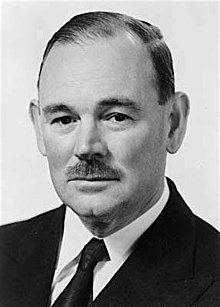Sir Paul Hasluck | |
|---|---|
 Hasluck in 1960 | |
| 17th Governor-General of Australia | |
| In office 30 April 1969 – 11 July 1974 | |
| Monarch | Elizabeth II |
| Prime Minister | John Gorton William McMahon Gough Whitlam |
| Preceded by | The Lord Casey |
| Succeeded by | Sir John Kerr |
| Minister for External Affairs | |
| In office 24 April 1964 – 11 February 1969 | |
| Prime Minister | Robert Menzies Harold Holt John McEwen John Gorton |
| Preceded by | Garfield Barwick |
| Succeeded by | Gordon Freeth |
| Minister for Defence | |
| In office 18 December 1963 – 24 April 1964 | |
| Prime Minister | Robert Menzies |
| Preceded by | Athol Townley |
| Succeeded by | Shane Paltridge |
| Minister for Territories | |
| In office 11 May 1951 – 18 December 1963 | |
| Prime Minister | Robert Menzies |
| Preceded by | Richard Casey |
| Succeeded by | Charles Barnes |
| Member of the Australian Parliament for Curtin | |
| In office 11 December 1949 – 12 February 1969 | |
| Preceded by | Division created |
| Succeeded by | Victor Garland |
| Personal details | |
| Born | Paul Meernaa Caedwalla Hasluck 1 April 1905 Fremantle, Western Australia, Australia |
| Died | 9 January 1993 (aged 87) Dalkeith, Western Australia, Australia |
| Resting place | Karrakatta Cemetery |
| Political party | Liberal Party of Australia |
| Spouse | |
Sir Paul Meernaa Caedwalla Hasluck, KG, GCMG, GCVO, PC (1 April 1905 – 9 January 1993) was an Australian statesman who served as the 17th Governor-General of Australia, in office from 1969 to 1974. Prior to that, he was a Liberal Party politician, holding ministerial office continuously from 1951 to 1969.
Hasluck was born in Fremantle, Western Australia, and attended Perth Modern School and the University of Western Australia. After graduation he joined the university as a faculty member, eventually becoming a reader in history. Hasluck joined the Department of External Affairs during World War II, and served as Australia's first Permanent Representative to the United Nations from 1946 to 1947. He would later contribute two volumes to Australia in the War of 1939–1945, the official history of Australia's involvement in the war.
In 1949, Hasluck was elected to federal parliament for the Liberal Party, winning the Division of Curtin. In 1951, less than two years after entering politics, he was made Minister for Territories in the Menzies Government. In his twelve years in the position, he initiated transitions toward self-government in Australia's territories, including Nauru, Papua New Guinea, and the Northern Territory. Hasluck later served as Minister for Defence (1963–1964) and Minister for External Affairs (1964–1969). His tenure in those positions covered Australia's involvement in the Indonesia–Malaysia confrontation and the first years of the Vietnam War.
After the disappearance of Harold Holt, Hasluck unsuccessfully stood in the resulting Liberal leadership election. He initially stayed on in cabinet under the new prime minister, John Gorton, but in 1969 Gorton instead nominated him to replace Lord Casey as governor-general. In his five years in the position, Hasluck saw two previous political adversaries (William McMahon and Gough Whitlam) become prime minister; he maintained good working relationships with both. In retirement, he was a prolific author, publishing an autobiography, several volumes of poetry, and multiple works on Australian history.